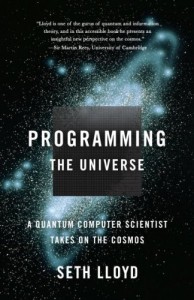
The author of this book, Seth Lloyd, is quite an interesting person. He is a theoretical physicist and professor at MIT in the Mechanical Engineering department, of all places. He considers himself the first quantum-mechanical engineer and has created quite a neat niche for himself in this realm. I have had the pleasure of meeting him on 2 occasions and his quirky personality and brilliance really do come out in this book!
Seth does a great job in defending one of his very controversial ideas that the universe itself is a quantum computer. Many people do not believe this is an accurate model for the universe based on varying reasons but I tend to like the idea. Seth starts off by gently leading the reader through some basic computer science and physics terminology and bringing the reader up to speed on concepts like Maxwell’s Demon and information-theoretic ideas. He then takes the reader on a winding path of why the universe is itself a quantum computer, ever computing with every collision of elementary particles (he rehashes himself quite a bit in the process, most likely because it is a popular science novel so for the scientific it can get slow at some points).
This idea of the universe being a huge quantum computer is the heart of this book. He portrays each fundamental particle as part of a symphony of bits computing till the end of time. He explains the circuit model of quantum computation and how a quantum computer is indistinguishable from the universe itself, he talks about how the different levels of complexity of system are direct effects from the Big Bang, and many more. All these are fascinating ideas but the real interesting twist for me came when he introduces the idea that this model can easily be used as a model for quantum gravity. This struck me as quite odd. I did not expect this from his book but it is nice to hear his ideas on some of the topics in quantum gravity as opposed to the leader in the field, Lee Smolin (See Three Roads to Quantum Gravity for more).
Overall this book was quite good. It gives a good introduction for the layperson on many things quantum and explains very straightforward how these quantum weird-ities can be used to compute. Even for someone who has a strong computer science or physics background, this book offers a good dose of fresh ideas about information and how complexity is viewed from a purely physical standpoint. I would recommend it to anyone interested in getting into quantum information processing!

